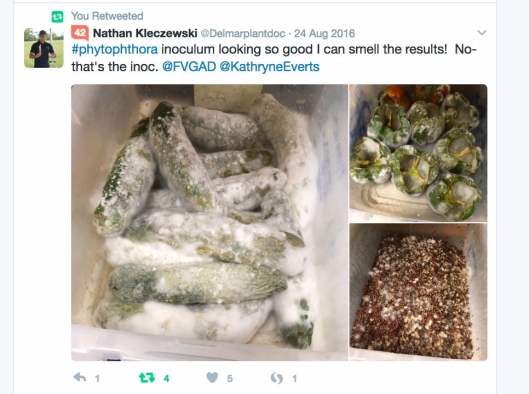What is the best social media platform for a Cooperative Extension agent or specialist to use?
With a full menu of social media platforms to choose from, it’s a dizzying process deciding which platform packs the most punch for the Extension educator. For the input of time required weighed against the impact of the message, Twitter rises to the top as a valuable tool.
Twitter is perfect for the Extension professional who desires to reach constituents, peers, as well as introduce Extension to new audiences. We’re supposed to be using “All Reasonable Efforts” aren’t we? Twitter is more than reasonable. It’s mobile friendly, quick and concise. Most of the time, you’re sharing a brief moment, an impression, or a helpful fact. Most importantly, you are putting a face the public can associate with the Cooperative Extension Service and its mission to Extend Knowledge and Change Lives through research-based outreach.
Who’s on Twitter?
1. Reporters, print and broadcast media are strong users of Twitter.
2. Legislators, policy and decision makers, at all levels, are heavily invested in Twitter.
3. Industry, trade, researchers, land grant universities, non-profits, funders and grantors all have a strong presence on Twitter.
4. Bloggers and other influencers, particularly parent-bloggers have long favored the blue bird.
Nationally, Cooperative Extension offices are well-positioned on Twitter. Individual educators, agents, and specialists are needed to put a face on these efforts and add personal perspective to the conversation.
What should Extension professionals tweet about?
1. Day-in-the-life activities. What is routine to you may be utterly fascinating to someone else. Demonstrate and illustrate your outreach and research.
2. Use photos (landscape orientation works best) Short videos up to 2 minutes, 20 seconds. Insects, diseases, fungi, beautiful pastoral scenes are all worthy topics to share..

Early on, our plant pathologist used humor and graphics to communicate what he does on a daily basis. Since this shot a year ago, his influence and following among peers and constituents have grown considerably.
3. Comment on other Extension topics/tweets. This is called quoting a tweet. You preface the share with a short lead-in or take away why you are sharing. Engagement in social media (all platforms, not just Twitter) is key to building a following and developing your brand.
4.Without commentary, you can quickly share content using the retweet arrows. See an article or photo you like? Share it instantly with your followers with one tap.
5. Original content. A photo, video, a link to your blog or fact sheet. Promote an upcoming field day, workshop or event

With apps like Word Swag or Adobe Spark, it’s easy to add text overlay to an image to advertise an event. Photo use like this saves on the 140 character limit and visually pops in someone’s feed.
6. Respond to other people’s content. Compliment a useful article or photo.
7. Say thank you. Thank people for their support, their expertise, or for following you.
8. Extension professionals can also participate in larger organized chats or tweet-ups, usually regularly-scheduled hour-long conversations that span national or global discussions around a specific interest. For example, search for #GardenChat, #AgChat, #FoodChat, #EdTechLN (Extension technology) #SoilChat and many, many others.
Getting started:
1. Upload a good headshot and header image.
2. Fill out a profile. Say who you are, where you work. You can share one link in your profile, usually your work website.
3. Understand how hashtags work. Use two or three at a maximum. Hashtags are keywords used for searching and curating. Search for #soybeans, #4H, #FoodSafety #fusarium, #dairy and you can follow people and contribute content germane to your specialty or interest.
4. Learn the hashtags that are popular in your location, or that are used at your land grant institution. Social media managers continually curate these hashtags and discover you because you use the same hashtag!
5. Want to tap someone on the shoulder (virtually) to get their attention? Tag them by using their handle @twittername.
6. Don’t be afraid to repeat important information, though it’s good to not do that consecutively. An important workshop coming up? Tweet it on Monday morning, Wednesday afternoon, and again on Friday night. In between, you should have other content or engagement with others.
7. Build slowly. Find someone you respect, perhaps in your field, and follow a few of the people they are following. Follow your local media and representatives.
8. Check a profile before following someone back. Generally, I take a look at their how they describe themselves, and review the kind of content they are tweeting. If it is repetitive, or if they only tweet for one site, I ignore them. Look for real people who tweet about the topics you are interested in.
9. Don’t be a wonk. Your Twitter content should be meaningful, of course, but there’s nothing wrong with revealing your sense of humor or something that shows potential followers you are an authentic human being.
10. If setting up a professional profile, avoid politics, religion or any topic that could be construed as controversial. If you feel compelled to express yourself on such topics, I recommend setting up another account for such purposes. Read more about professional vs personal branding here.
Start at a pace you are comfortable with. Talk to your institution’s communication team on any branding requirements or practices specific to your college or university. They will be happy to give you suggestions and best practices.
See you on Twitter @mwalfred I’ll be looking for you!
